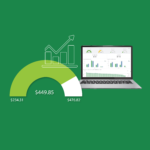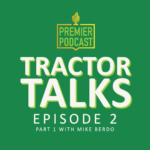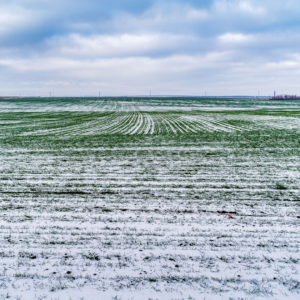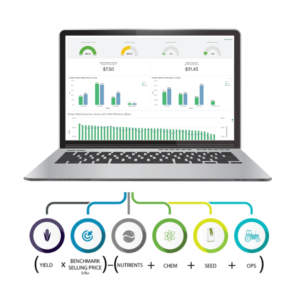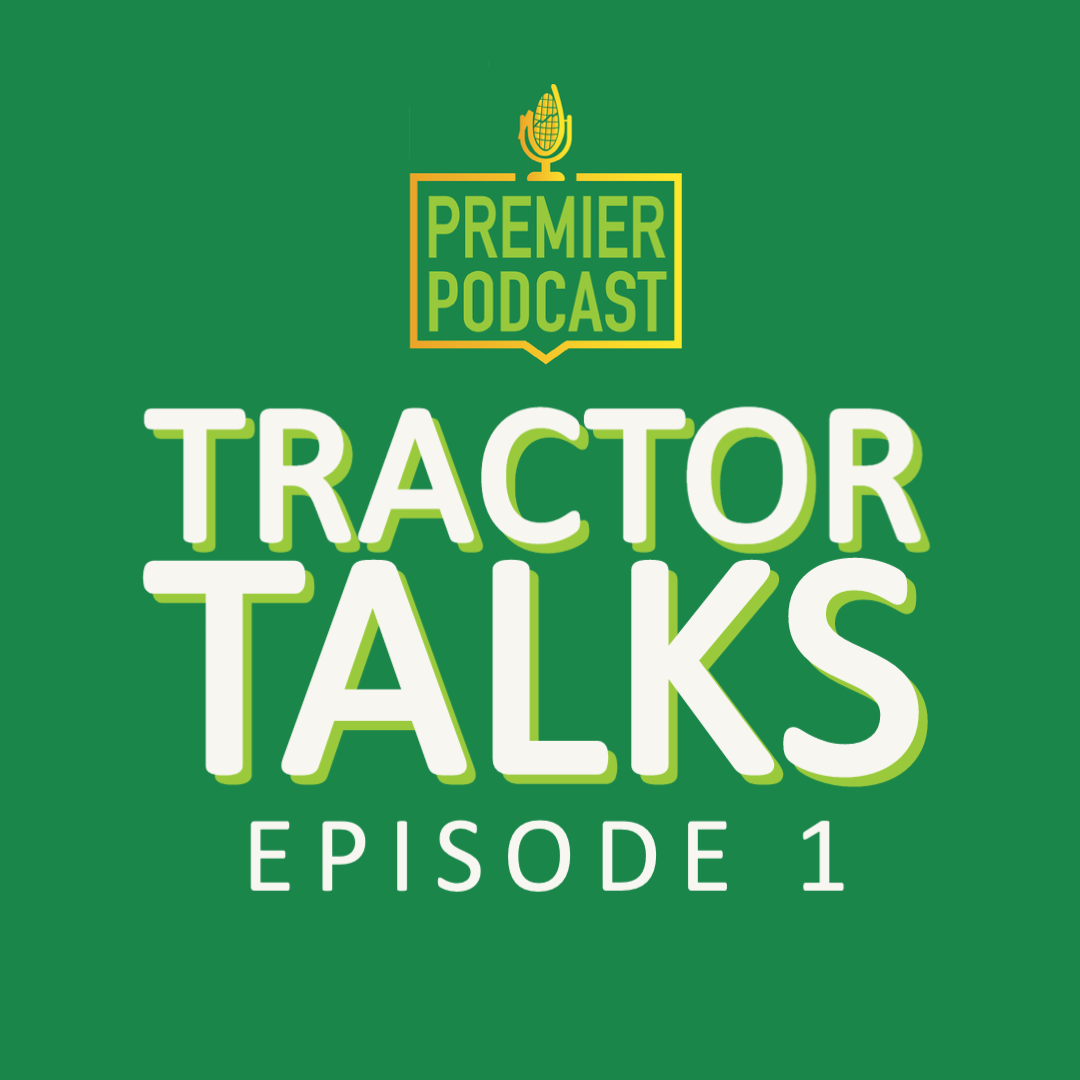
Tractor Talks is a mini series here on the Premier Podcast where we join growers in their tractor cabs during the spring and hear candid thoughts on precision ag.
This series is hosted by Katie McWhirter, Manager of Training and Development at Premier Crop Systems.
If you are enjoying the show, tweet us using #PremierPodcast.
RENEE HANSEN: Welcome to the Premier Podcast miniseries ‘Tractor Talks.’ This is a series comprised of talks in the tractor cab with one of Premier Crop’s advisors, Katie McWhirter, and growers as they are planting this spring. Listen to what their real, honest thoughts are when it comes to nitrogen management, technology and precision ag.
KATIE MCWHIRTER: Okay, Noah, so you just said it’s crazy where this technology is going. Elaborate on that.
NOAH: Our planter is from 2009, and it’ll tell you all these things, down to a tenth of a percent for simulation, downforce and all the stuff you want to know while you’re doing it.
KATIE MCWHIRTER: So, why do you want to know that?
NOAH: It gives me an idea of how fast I can go in the field. It helps me be efficient with the equipment from field condition to field condition because our down pressure and ground contact relate to seed depth. The seed spacing relates to seed spacing, and all those things relate to yield. If I’m in a nice, smooth field, I can cruise. If I’m in a rough field, I can slow down, and I can see the difference.
KATIE MCWHIRTER: What’d you do before?
NOAH: Just went slow. You had to go a certain speed because that’s how you were trained, or that’s what somebody told you was the right speed. Now, with being able to see what the planter’s doing, as far as staying in contact with the ground, being able to see what speed does to accuracy. I can vary that from field to field and be a lot more efficient. I would’ve never guessed I could plant 6-7 miles an hour with a planter that’s 10 years old and doing a good job. There are a few conditions when it’s just right. You could do that. Then there are times where you’ve got to go four miles an hour.
KATIE MCWHIRTER: So, what made you decide to use all this technology?
NOAH: When I started farming full time, when I left the dealership, I was pretty aware of it, just from selling it at the dealership. After using it day in and day out, you really start to understand the value of it.
KATIE MCWHIRTER: What struggles have you had?
NOAH: Generations. So, your account rep at the co-op, if they embrace it, can be really helpful. If they don’t embrace it, that becomes a challenge. Or seed rep, the same type of deal.
KATIE MCWHIRTER: Why do you think they don’t embrace it?
NOAH: I think it’s a generational thing. The younger people or middle-aged people probably do more than most of the traditional retirement-age guys, but I say that tongue in cheek. My uncle is a retirement-age kind of guy and really appreciates the return that you see on knowing what you’re doing and the ease of operation with auto-steer and things like that. So, that’s a challenge. It’s also an asset when you find somebody that does embrace it. It’s tough when I park the planter, when a seed tube sensor isn’t quite reading right or something, but you still want accurate data. So, it’s like, I know I can plant. I know the planter is doing a good job, but the information it’s recording isn’t accurate right now, and so those are tough days. I’m more or less disciplined based on what the weather’s doing on most things.
KATIE MCWHIRTER: I had a grower yesterday tell me, he said: ‘Technology is great when it’s working. When it doesn’t work, and I have to stop just to fix the technology, when I know I could be planting, and I could have 10 more acres done, that’s the hard part. To be disciplined.’
NOAH: It’s not a flat tire, right? You can keep going.
KATIE MCWHIRTER: Right.
NOAH: For me, it’s just recognizing them. You don’t know what we don’t know, and so we’ve got to report it and then try it.
KATIE MCWHIRTER: Interesting. So, what are some of the things you’ve learned as you’ve used this technology and the data?
NOAH: We’ve changed our fertility programs based on analysis and realized that phosphorus doesn’t have a significant return at higher levels. Parts per million north of 40 or 30 are just a waste of effort, to a certain extent. Yeah, so like the soybean population thing, right? So, we’ve learned that we don’t have to be at 150,000 planted seeds to have 70-80 bushel beans.
KATIE MCWHIRTER: Or where we started, oh my goodness, 2014-15? When did you and I start working together? 180,000? Right?
NOAH: So, even just in the last 12 months, we’ve realized that, in our C zones, we don’t need to be up in that 167.
KATIE MCWHIRTER: Well, I think that’ll be even more interesting. Where we had pushed in those C zones for population on beans but not tying the economics to it, it was strictly yield. I think that, then, puts another layer of learning on top of it. Because all right, well, maybe we are yielding the same, but is the extra 40,000 seeds whatever we were pushing?
NOAH: A discussion Molly and I had this spring was in our A zones. Last year, we had 120,000 as our target. And we had high and low checks in our A zones of like 90,000 and 150,000, and they were all within a bushel of each other. So, there was really no rhyme or reason to the population piece of it.
KATIE MCWHIRTER: Right.
NOAH: And so, then, we said: ‘Why don’t we plant our A inside of 100,000?’ Then, we did the same in our C zones. I look at my B zone as kind of the field average. So, I don’t do a lot with the B zone. I try to do my learning in the A and the C. So, in the C zones, we had targets of 170-180,000, and we had some checks in there at 200 and some checks at 150, and same thing. I saw yield reduction at 200,000, and the same at 150 as we did at 180. Then, it was, well, maybe our C zones need to be lower. If you think about what you’re doing there agronomically, you’re asking a below-average piece of soil or area of the soil to produce seeds on 180,000 plants.
KATIE MCWHIRTER: Right.
NOAH: It kind of goes against what you’re asking. So, we back it off to try and get a little healthier plant or seed size. Bean size has been bigger in the lower populated areas, and they’ll tell you at your Pioneer meetings that corn yield comes from kernel size. So, the bigger the kernel, the bigger the corn yield. Then, the same would apply to beans to a certain extent. So, we’re kind of exploring that a little bit.
KATIE MCWHIRTER: That’s interesting. What’s the next thing in technology or precision ag?
NOAH: That’s always the big question. What’s next? For me, it’s updating, getting caught up, maybe doing the same thing we’re doing with a little newer equipment. So, my 20/20 SeedSense is Generation 1 stuff.
KATIE MCWHIRTER: Right.
NOAH: Whether I trade planters or upgrade this planter to some of the higher speed technology, with the hydraulic downforce and things, that’s kind of where I’m at. Getting a little more current. Autonomous equipment’s going to be a big deal. It is, but I don’t know if that’s a 20-foot planter holding a 100-horsepower unit or something, or if that’s great, big planters. I don’t know where that direction’s going, but it’s just so hard to come by it. I didn’t have seven kids. My grandpa was smarter than anybody gives him credit for. He had seven kids. Out of seven, only one stuck around to farm, so I don’t know. Maybe he didn’t do it all right, either. I don’t know.
KATIE MCWHIRTER: It’s interesting. I had yesterday’s grower say the same thing about autonomous. I asked if it was going to be big, like operations. Or if it’d be more of the in-between-the-row sprayer — smaller to be able to go through, work all night, identify pests, weeds, nutrient deficiencies, to be able to apply those.
NOAH: To a certain extent, the equipment precision industry threw a bunch of stuff at the wall to see what sticks. So, we’re kind of at the mercy of what’s available to us. The other thing that we’re really working on, away from the equipment but in the agronomics of it, is just efficiency of fertilizer. If our yield target is 300 on a field, say today we’re averaging 270-80 on a farm, and our target’s 300, is that wiper nutrients that get us there?
KATIE MCWHIRTER: Right.
NOAH: We’ve got our macros, our N, P and K, at pretty high figures. So, what’s that next thing that consistently gets you there? If Mother Nature cooperates on an average year, and you’re at 270-80, what makes that 300 on an average year?
KATIE MCWHIRTER: Look back 5-10 years ago. Sulfur wasn’t really anything. I mean, it was a micro. And now, I mean, sulfur is such an important part of most people’s fertility programs. They realize it.
NOAH: We spray a lot of acres for higher feed co-ops, and every corn acre has got ATS on it. And now, on our farm, every bean acre has got some form of sulfur.
KATIE MCWHIRTER: Wow.
RENEE HANSEN: Thanks for listening to the Premier Podcast, where everything agronomic is economic. Please subscribe, rate and review this podcast so we can continue to provide the best precision ag and analytic results for you. And to learn more about Premier Crop, visit our blog at premiercrop.com.
___________________________________________________________________________________________
- For more helpful tips and insight on all things data and agriculture, visit our blog at http://info.premiercrop.com/blog
- Curious about precision ag? Download our 5 Steps to Getting Started Guide: http://info.premiercrop.com/5-steps-guide
- Ready to cut through the bull? Download our No Bull Guide to Precision Ag: http://info.premiercrop.com/field-profitability-guide
- Podcast provided by Premier Crop Systems. Learn more about us at https://www.premiercrop.com

